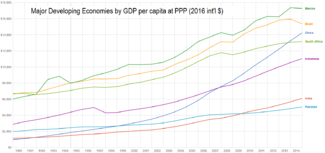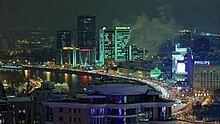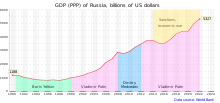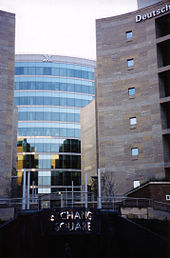The BRICS countries
BRICS is the acronym for an association of five major emerging national economies: Brazil, Russia, India, China and South Africa.[4] The grouping was originally known as "BRIC" before the inclusion of South Africa in 2010. The BRICS members are all developing or newly industrialised countries, but they are distinguished by their large, fast-growing economies and significant influence on regional and global affairs; all five are G-20 members.[5] Since 2010, the BRICS nations have met annually at formal summits. Russia currently holds the chair of the BRICS group, and will host the group's seventh summit in July 2015.
As of 2014, the five BRICS countries represent almost 3 billion people, or approximately 40% of the world population. The five nations have a combined nominal GDP of US$16.039 trillion, equivalent to approximately 20% of the gross world product, and an estimated US$4 trillion in combined foreign reserves.[2][6] The BRICS have received both praise and criticism from numerous commentators.[7][8][9]
History
The term "BRICS" was coined in 2001 by then-chairman of Goldman Sachs Asset Management, Jim O'Neill, in his publication Building Better Global Economic BRICs.[10] The foreign ministers of the initial four BRIC states (Brazil, Russia, India, and China) met in New York City in September 2006, beginning a series of high-level meetings. A full-scale diplomatic meeting was held in Yekaterinburg, Russia, on 16 June 2009.[11]
First BRIC summit
The BRIC grouping's first formal summit, also held in Yekaterinburg, commenced on 16 June 2009,[12] with Luiz Inácio Lula da Silva, Dmitry Medvedev, Manmohan Singh, and Hu Jintao, the respective leaders of Brazil, Russia, India and China, all attending.[13] The summit's focus was on means of improving the global economic situation and reforming financial institutions, and discussed how the four countries could better co-operate in the future.[12][13] There was further discussion of ways that developing countries, such as the BRIC members, could become more involved in global affairs.[13]
In the aftermath of the Yekaterinburg summit, the BRIC nations announced the need for a new global reserve currency, which would have to be "diversified, stable and predictable".[14] Although the statement that was released did not directly criticise the perceived "dominance" of the US dollar – something that Russia had criticised in the past – it did spark a fall in the value of the dollar against other major currencies.[15]
Brazil
Brazil is the largest national economy in Latin America, the world's seventh largest economy at market exchange rates and the seventh largest in purchasing power parity (PPP), according to the International Monetary Fund and the World Bank. Brazil has a mixed economy with abundant natural resources. The Brazilian economy has been predicted to become one of the five largest in the world in the decades to come, the GDP per capita following and growing,[200] provided that large investments in productivity gains are made to substitute the GDP growth of the last decade that is attributable to the increase in the number of people working.[201] Its current GDP (PPP) per capita is $15,153 in 2014[6] putting Brazil in the 77th position according to IMF data. Active in agricultural, mining, manufacturing and service sectors Brazil has a labor force of over a 107 million (ranking 6th worldwide) and unemployment of 6.2% (ranking 64th worldwide).[202]
The country has been expanding its presence in international financial and commodities markets, and is one of a group of four emerging economies called the BRIC countries.[203] Brazil has been the world's largest producer of coffee for the last 150 years.[23] It has become the fourth largest car market in the world.[204] Major export products include aircraft, electrical equipment, automobiles, ethanol, textiles, footwear, iron ore, steel, coffee, orange juice, soybeans and corned beef.[205] Adding up, Brazil ranks 23rd worldwide in value of exports.
Brazil pegged its currency, the real, to the U.S. dollar in 1994. However, after the East Asian financial crisis, the Russian default in 1998[206] and the series of adverse financial events that followed it, the Central Bank of Brazil temporarily changed its monetary policy to a managed-float[207] scheme while undergoing a currency crisis, until definitively changing the exchange regime to free-float in January 1999.[208]

Brazil received an International Monetary Fund rescue package in mid-2002 of $30.4 billion,[210] then a record sum. Brazil's central bank paid back the IMF loan in 2005, although it was not due to be repaid until 2006.[211] One of the issues the Central Bank of Brazil recently dealt with was an excess of speculative short-term capital inflows to the country, which may have contributed to a fall in the value of the U.S. dollar against the real during that period.[212] Nonetheless, foreign direct investment (FDI), related to long-term, less speculative investment in production, is estimated to be $193.8 billion for 2007.[213] Inflation monitoring and control currently plays a major part in the Central bank's role of setting out short-term interest rates as a monetary policy measure.[214]
Between 1993 and 2010, 7012 mergers & acquisitions with a total known value of $707 billion with the involvement of Brazlian firms have been announced.[215] The year 2010 was a new record in terms of value with 115 billion USD of transactions. The largest transaction with involvement of Brazilian companies has been: Cia Vale do Rio Doce acquired Inco in a tender offer valued at US$18.9 billion.
Russia
Russia has a developed, high-income market economy with enormous natural resources, particularly oil and natural gas. It has the 9th largest economy in the world by nominal GDP and the 6th largest by purchasing power parity (PPP). Since the turn of the 21st century, higher domestic consumption and greater political stability have bolstered economic growth in Russia. The country ended 2008 with its ninth straight year of growth, but growth has slowed with the decline in the price of oil and gas. Real GDP per capita, PPP (current international) was 19,840 in 2010.[158] Growth was primarily driven by non-traded services and goods for the domestic market, as opposed to oil or mineral extraction and exports.[92] The average nominal salary in Russia was $967 per month in early 2013, up from $80 in 2000.[159][160] In March 2014 the average nominal monthly wages reached 30,000 RUR (or US$980),[161][162] while tax on the income of individuals is payable at the rate of 13% on most incomes.[163] Approximately 12.8% of Russians lived below the national poverty line in 2011,[164] significantly down from 40% in 1998 at the worst point of the post-Soviet collapse.[88] Unemployment in Russia was at 5.4% in 2014, down from about 12.4% in 1999.[165] The middle class has grown from just 8 million persons in 2000 to 104 million persons in 2013.[166][167] Sugar imports reportedly dropped 82% between 2012 and 2013 as a result of the increase in domestic output.[168]
Oil, natural gas, metals, and timber account for more than 80% of Russian exports abroad.[92] Since 2003, the exports of natural resources started decreasing in economic importance as the internal market strengthened considerably. Despite higher energy prices, oil and gas only contribute to 5.7% of Russia's GDP and the government predicts this will be 3.7% by 2011.[169] Oil export earnings allowed Russia to increase its foreign reserves from $12 billion in 1999 to $597.3 billion on 1 August 2008, the third largest foreign exchange reserves in the world.[170] The macroeconomic policy under Finance Minister Alexei Kudrin was prudent and sound, with excess income being stored in the Stabilization Fund of Russia.[171] In 2006, Russia repaid most of its formerly massive debts,[172] leaving it with one of the lowest foreign debts among major economies.[173] The Stabilization Fund helped Russia to come out of the global financial crisis in a much better state than many experts had expected.[171]
India

According to the International Monetary Fund (IMF), as of 2014, the Indian economy is nominally worth US$2.047 trillion; it is the 10th-largest economy by market exchange rates, and is, at US$7.277 trillion, the third-largest by purchasing power parity, or PPP.[9] With its average annual GDP growth rate of 5.8% over the past two decades, and reaching 6.1% during 2011–12,[204] India is one of the world's fastest-growing economies.[205] However, the country ranks 140th in the world in nominal GDP per capita and 129th in GDP per capita at PPP.[206] Until 1991, all Indian governments followed protectionist policies that were influenced by socialist economics. Widespread state intervention and regulation largely walled the economy off from the outside world. An acute balance of payments crisis in 1991 forced the nation to liberalise its economy;[207] since then it has slowly moved towards a free-market system[208][209] by emphasising both foreign trade and direct investment inflows.[210] India's recent economic model is largely capitalist.[209] India has been a member of WTO since 1 January 1995.[211]
The 486.6-million worker Indian labour force is the world's second-largest, as of 2011.[197] The service sector makes up 55.6% of GDP, the industrial sector 26.3% and the agricultural sector 18.1%. Major agricultural products include rice, wheat, oilseed, cotton, jute, tea, sugarcane, and potatoes.[176] Major industries include textiles, telecommunications, chemicals, pharmaceuticals, biotechnology, food processing, steel, transport equipment, cement, mining, petroleum, machinery, and software.[176] In 2006, the share of external trade in India's GDP stood at 24%, up from 6% in 1985.[208] In 2008, India's share of world trade was 1.68%;[212] In 2011, India was the world's tenth-largest importer and the nineteenth-largest exporter.[213] Major exports include petroleum products, textile goods, jewellery, software, engineering goods, chemicals, and leather manufactures.[176] Major imports include crude oil, machinery, gems, fertiliser, and chemicals.[176] Between 2001 and 2011, the contribution of petrochemical and engineering goods to total exports grew from 14% to 42%.[214] India was the second largest textile exporter after China in the world in calender year 2013.[215]
Averaging an economic growth rate of 7.5% for several years prior to 2007,[208] India has more than doubled its hourly wage rates during the first decade of the 21st century.[216] Some 431 million Indians have left poverty since 1985; India's middle classes are projected to number around 580 million by 2030.[217] Though ranking 51st in global competitiveness, India ranks 17th in financial market sophistication, 24th in the banking sector, 44th in business sophistication, and 39th in innovation, ahead of several advanced economies, as of 2010.[218] With 7 of the world's top 15 information technology outsourcing companies based in India, the country is viewed as the second-most favourable outsourcing destination after the United States, as of 2009.[219] India's consumer market, currently the world's eleventh-largest, is expected to become fifth-largest by 2030.[217]
China

As of 2013, China has the world's second-largest economy in terms of nominal GDP, totalling approximately US$9.469 trillion according to the International Monetary Fund.[12] If purchasing power parity (PPP) is taken into account, China's economy is again second only to the United States, with a 2013 PPP GDP of US$16.149 trillion.[12] In 2013, its PPP GDP per capita was US$11,868, while its nominal GDP per capita was US$6,959. Both cases put China behind around ninety countries (out of 183 countries on the IMF list) in global GDP per capita rankings.[244]
China is a member of the WTO and is the world's largest trading power, with a total international trade value of US$3.87 trillion in 2012.[22] Its foreign exchange reserves reached US$2.85 trillion by the end of 2010, an increase of 18.7% over the previous year, making its reserves by far the world's largest.[264][265] In 2012, China was the world's largest recipient of inward foreign direct investment (FDI), attracting $253 billion.[266] China also invests abroad, with a total outward FDI of $62.4 billion in 2012,[266] and a number of major takeovers of foreign firms by Chinese companies.[267] In 2009, China owned an estimated $1.6 trillion of US securities,[268] and was also the largest foreign holder of US public debt, owning over $1.16 trillion in US Treasury bonds.[269][270] China's undervalued exchange rate has caused friction with other major economies,[182][271][272] and it has also been widely criticized for manufacturing large quantities of counterfeit goods.[273][274]
 |
| Graph comparing the 2013 nominal GDPs of major economies in US$ billions, according to IMF data[275] |
China ranked 29th in the Global Competitiveness Index in 2009,[276] although it is only ranked 136th among the 179 countries measured in the 2011 Index of Economic Freedom.[277] In 2014, Fortune's Global 500 list of the world's largest corporations included 95 Chinese companies, with combined revenues of US$5.8 trillion.[278] The same year, Forbes reported that five of the world's ten largest public companies were Chinese, including the world's largest bank by total assets, the Industrial and Commercial Bank of China.[279]
South Africa
South Africa has a mixed economy, the second largest in Africa after Nigeria. It also has a relatively high GDP per capita compared to other countries in Sub-Saharan Africa ($11,750 at PPP as of 2012). Despite this, South Africa is still burdened by a relatively high rate of poverty and unemployment, and is also ranked in the top 10 countries in the world for income inequality,[111][112][113] measured by the Gini coefficient. Unlike most of the world's poor countries, South Africa does not have a thriving informal economy; according to OECD estimates, only 15% of South African jobs are in the informal sector, compared with around half in Brazil and India and nearly three-quarters in Indonesia. The OECD attributes this difference to South Africa's widespread welfare system.[114] World Bank research shows that South Africa has one of the widest gaps between per capita GNP versus its Human Development Index ranking, with only Botswana showing a larger gap.[115]
After 1994 government policy brought down inflation, stabilised public finances, and some foreign capital was attracted, however growth was still subpar.[116] From 2004 onward economic growth picked up significantly; both employment and capital formation increased.[116]
South Africa is a popular tourist destination, and a substantial amount of revenue comes from tourism.[117] Illegal immigrants are involved in informal trading.[118] Many immigrants to South Africa continue to live in poor conditions, and the immigration policy has become increasingly restrictive since 1994.[119]
Principal international trading partners of South Africa—besides other African countries—include Germany, the United States, China, Japan, the United Kingdom and Spain.[120]
The South African agricultural industry contributes around 10% of formal employment, relatively low compared to other parts of Africa, as well as providing work for casual labourers and contributing around 2.6% of GDP for the nation.[121] Due to the aridity of the land, only 13.5% can be used for crop production, and only 3% is considered high potential land.[122]
Acknowledgements
The content of this lesson was taken from the Wikipedia article on BRICS and the Economy sections of each of the respective countries' articles. The text and image content is available under the Creative Commons Attribution-ShareAlike License.



